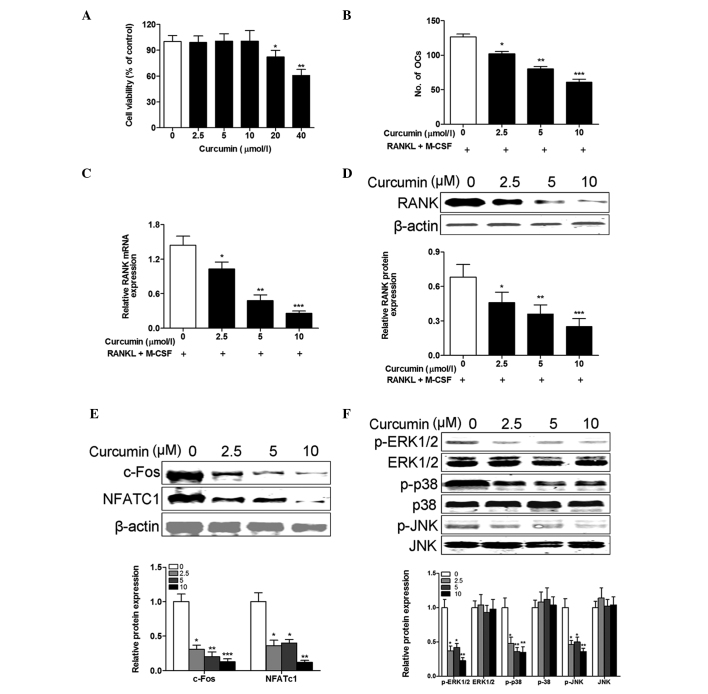Figure 4.
Curcumin inhibits the osteoclastogenic potential of PBMCs from patients with RA. (A) PBMCs from healthy controls were incubated with various concentrations of curcumin (0–40 µM) in the presence of M-CSF (50 ng/ml) and RANKL (100 ng/ml) for 48 h, and the cell viability was examined using the Cell Counting kit-8 assay. Cell viability was not affected by <20 µM curcumin. PBMCs from patients with RA were incubated with various concentrations of curcumin (0–10 µM) in the presence of 50 ng/ml M-CSF and 100 ng/ml RANKL for 14 days. (B) The osteoclast differentiation was measured by TRAP staining and the number of osteoclasts (TRAP-positive cells containing ≥3 nuclei/cell) was counted in 10 fields of each sample. Curcumin treatment inhibited the number of osteoclasts generated in a dose-dependent manner. The (C) mRNA and (D) protein expression levels of RANK were measured by reverse transcription-quantitative polymerase chain reaction and western blotting, respectively, and were reduced by curcumin treatment. (E) The protein expression levels of (E) c-Fos and NFATc1, and (F) p-ERK1/2, ERK1/2, p-p38, P-38, p-JNK and JNK were measured and normalized to β-actin. Curcumin treatment decreased the protein expression levels of c-Fos, NFATc1, p-ERK1/2, p-p38 and p-JNK in a dose-dependent manner. Data are expressed as the mean ± standard deviation, n=3 per group. *P<0.05, **P<0.01 and ***P<0.001 vs. 0 µmol/l curcumin treatment. PBMCs, peripheral blood mononuclear cells; M-CSF, macrophage colony-stimulating factor; RANKL, receptor activator of nuclear factor κB ligand; RA, rheumatoid arthritis; RANK, receptor activator of nuclear factor κB; TRAP, tartrate-resistant acid phosphatase; NFATc1, nuclear factor of activated T cells, cytoplasmic 1; p, phosphorylated; ERK1/2, extracellular signal-regulated kinases 1 and 2; JNK, c-Jun N-terminal kinase.

